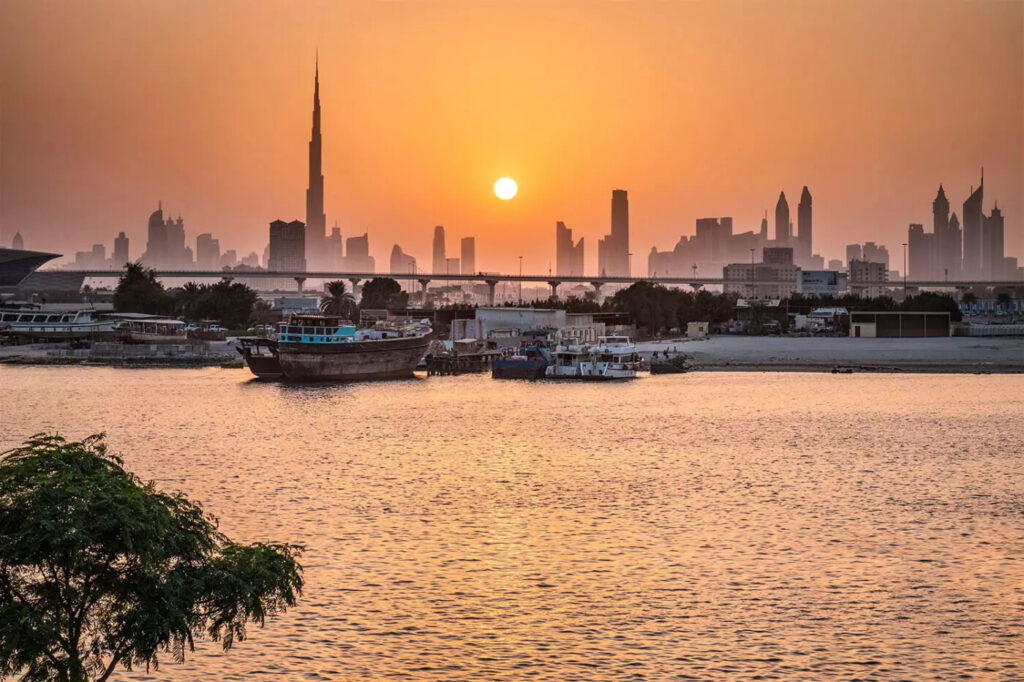
Shady, ornate courtyards, fragrant and golden alleys, small wooden boats, and lots of greenery: If you travel to Dubai, you cannot avoid visiting the old town of Dubai. A huge river separates the historic districts of Bur Dubai in the west and Deira in the east.
For a long time, the so-called Dubai Creek was the livelihood of the former fishing village on the Arabian Gulf. Where fishermen, pearl divers, and simple merchants docked at the natural inlets until the 1960s, people from the most diverse cultures still come together today and use the many opportunities along the pulsating watercourse.

In the north, just before the Dubai Creek flows into the Arabian Gulf, the Al Shindagha district is steeped in history on the west side of the inlet.
Traditional adobe houses with wind towers and decorations line up between narrow streets and the creek promenade. This is where the settlement of Dubai began and it was here that Sheikh Mohammed bin Rashid Al Maktoum, ruler of the Emirate of Dubai and Prime Minister of the United Arab Emirates, was born. The former home of the entire ruling family is now a museum, other historical sites such as the Saruq Al-Hadid Archaeological Museum, the Cultural, Heritage and Diving Village, the Al Shindagha Museum, or the Shindagha Watch Tower from 1939 can also be visited.
Here you can clearly understand the everyday life of the traditional Bedouin peoples, pearl divers, and fishermen. The district and the creek promenade were extensively restored just a few years ago and are definitely worth a visit and a stroll. Stroll through narrow streets, flowering and ornate backyards that provide pleasant shade, or look out over the creek banks, where old dhows, barges, and other ships cavort and get a good impression of how important the inlet is still for the shipping trade in the Arab metropolis. With the Al Ghubaiba metro station and the ferry station of the same name, the district is very well connected to the local public transport network.

Probably the best-known historical evidence of Dubai is the old town district Al Fahidi, also called Bastakiya.
Many Iranian immigrants settled here at the beginning of the 20th century and, similar to Al Shindagha, built mud houses with traditional wind towers, narrow streets, and beautiful squares. The quarter was threatened with demolition, but it remained and was extensively restored. This is also where the city’s probably oldest building is located: The Al Fahidi Fort dates back to 1787 and is now home to the Dubai Museum, in which the history of the desert city is presented.
READ: Ajman Fish Market: The Best Place To Create A Culinary Wonder
In the meantime, the beautiful old town has become a diverse artist and cultural quarter with many museums, galleries, and restaurants. The shady labyrinth of houses is ideal for strolling and strolling, the atmosphere is peaceful and calm. In the Sheikh Mohammed Center for Cultural Understanding, you can get to know the culture and way of life of the Emiratis during breakfast, lunch, or dinner. The Arabian Tea House or the XVA Gallery are popular stops for a stay in the Al Fahidi district.

The Dubai Creek is in the immediate vicinity of the Bastakiya, in the streets and alleys to the watercourse the hustle and bustle are getting bigger and busier.
READ: Cheap Hotels in Dubai: Where to Stay for the Budget Tourist
No wonder, because the dealers of the textile souk have their shops here, in which tons of clothes, souvenirs, and all kinds of trinkets are accumulated. The colorful market is not only colorful and loud but also a popular tourist destination. Here visitors can haggle extensively with the merchants, which inevitably leads to a nice chat with the Dubai residents.
If you reach the end of the covered market, you get to Abra Station Bur Dubai, where small wooden boats go to the opposite side of the creek for only one dirham per person. The crossing is an absolute “must-do” of a visit to Dubai and rewards the passengers with a wonderful all-around view of old Dubai. Alternatively, the Dubai Old Souq station is also available for ferry trips on the creek, which are only a few hundred meters apart.

A few kilometers south of Festival City, a new harbor district is currently being built on the city’s natural watercourse: Dubai Creek Harbor.
READ 20 NYC Media Tech Companies You Should Know
The port area is already well advanced, the promenade on the creek is already finished and invites you to stroll, and some skyscrapers all around are soaring. But the centerpiece will be the Dubai Creek Tower, a huge tower that will be even higher than the Burj Khalifa when it is completed. It should be over 1000 meters high and tower above everything that has been known so far. The completion is still open; it is expected between 2022 and 2024.

Design enthusiasts will be happy in the Palazzo Versace, just a stone’s throw from Festival City.
A grandiose Italian palace is presented here in the guise of a five-star luxury hotel. Responsible for this is not a prince or a king, but the famous Italian fashion label Versace. In the neo-baroque style, the luxury resort looks sophisticated, noble, and majestic. Marble floors, mosaics, chandeliers, and excellent pools are just some of the many proofs why the luxury hotel on the Creek is already one of the most desirable destinations on the Creek and in all of Dubai.